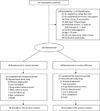Repurposing diflunisal for familial amyloid polyneuropathy: a randomized clinical trial
- PMID: 24368466
- PMCID: PMC4139164
- DOI: 10.1001/jama.2013.283815
Repurposing diflunisal for familial amyloid polyneuropathy: a randomized clinical trial
Abstract
Importance: Familial amyloid polyneuropathy, a lethal genetic disease caused by aggregation of variant transthyretin, induces progressive peripheral nerve deficits and disability. Diflunisal, a nonsteroidal anti-inflammatory agent, stabilizes transthyretin tetramers and prevents amyloid fibril formation in vitro.
Objective: To determine the effect of diflunisal on polyneuropathy progression in patients with familial amyloid polyneuropathy.
Design, setting, and participants: International randomized, double-blind, placebo-controlled study conducted among 130 patients with familial amyloid polyneuropathy exhibiting clinically detectable peripheral or autonomic neuropathy at amyloid centers in Sweden (Umeå), Italy (Pavia), Japan (Matsumoto and Kumamoto), England (London), and the United States (Boston, Massachusetts; New York, New York; and Rochester, Minnesota) from 2006 through 2012.
Intervention: Participants were randomly assigned to receive diflunisal, 250 mg (n=64), or placebo (n=66) twice daily for 2 years.
Main outcomes and measures: The primary end point, the difference in polyneuropathy progression between treatments, was measured by the Neuropathy Impairment Score plus 7 nerve tests (NIS+7) which ranges from 0 (no neurological deficits) to 270 points (no detectable peripheral nerve function). Secondary outcomes included a quality-of-life questionnaire (36-Item Short-Form Health Survey [SF-36]) and modified body mass index. Because of attrition, we used likelihood-based modeling and multiple imputation analysis of baseline to 2-year data.
Results: By multiple imputation, the NIS+7 score increased by 25.0 (95% CI, 18.4-31.6) points in the placebo group and by 8.7 (95% CI, 3.3-14.1) points in the diflunisal group, a difference of 16.3 points (95% CI, 8.1-24.5 points; P < .001). Mean SF-36 physical scores decreased by 4.9 (95% CI, -7.6 to -2.2) points in the placebo group and increased by 1.5 (95% CI, -0.8 to 3.7) points in the diflunisal group (P < .001). Mean SF-36 mental scores declined by 1.1 (95% CI, -4.3 to 2.0) points in the placebo group while increasing by 3.7 (95% CI, 1.0-6.4) points in the diflunisal group (P = .02). By responder analysis, 29.7% of the diflunisal group and 9.4% of the placebo group exhibited neurological stability at 2 years (<2-point increase in NIS+7 score; P = .007).
Conclusions and relevance: Among patients with familial amyloid polyneuropathy, the use of diflunisal compared with placebo for 2 years reduced the rate of progression of neurological impairment and preserved quality of life. Although longer-term follow-up studies are needed, these findings suggest benefit of this treatment for familial amyloid polyneuropathy.
Trial registration: clinicaltrials.gov Identifier: NCT00294671.
Conflict of interest statement
Figures

References
-
- Monaco HL, Rizzi M, Coda A. Structure of a complex of two plasma proteins: transthyretin and retinol-binding protein. Science. 1995;268(5213):1039–1041. - PubMed
-
- Blake CC, Geisow MJ, Oatley SJ, Rerat B, Rerat C. Structure of prealbumin: secondary, tertiary and quaternary interactions determined by Fourier refinement at 1.8 A. Journal of molecular biology. 1978;121(3):339–356. - PubMed
-
- Colon W, Kelly JW. Partial denaturation of transthyretin is sufficient for amyloid fibril formation in vitro. Biochemistry. 1992;31(36):8654–8660. - PubMed
-
- Foss TR, Wiseman RL, Kelly JW. The pathway by which the tetrameric protein transthyretin dissociates. Biochemistry. 2005;44(47):15525–15533. - PubMed
-
- Andrade C. A peculiar form of peripheral neuropathy; familiar atypical generalized amyloidosis with special involvement of the peripheral nerves. Brain : a journal of neurology. 1952;75(3):408–427. - PubMed
Publication types
MeSH terms
Substances
Associated data
Grants and funding
LinkOut - more resources
Full Text Sources
Other Literature Sources
Medical
Research Materials

